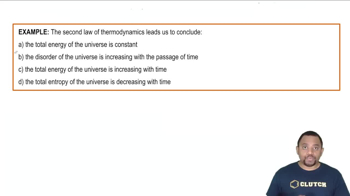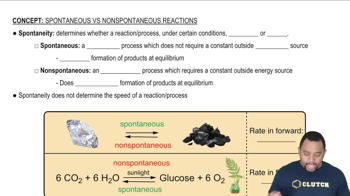All the oxides of nitrogen have positive values of ΔG°f at 298 K, but only one common oxide of nitrogen has a positive ΔS°f. Identify that oxide of nitrogen without reference to thermodynamic data and explain.

Is the sign of ΔSuniv for each process positive or negative? Explain for the following: b. the electrolysis of H2O(l) to H2(g) and O2(g) at 298 K c. the growth of an oak tree from a little acorn.
 Verified step by step guidance
Verified step by step guidanceKey Concepts
Entropy (ΔS)

Second Law of Thermodynamics

Spontaneity of Processes

The values of ΔG°f for the hydrogen halides become less negative with increasing atomic number. The ΔG°f of HI is slightly positive. However, the trend in ΔS°f is to become more positive with increasing atomic number. Explain.
Indicate and explain the sign of ΔSuniv for each process. a. 2 H2(g) + O2(g) → 2 H2O (l) at 298 K.
A metal salt with the formula MCl2 crystallizes from water to form a solid with the composition MCl2 • 6 H2O. The equilibrium vapor pressure of water above this solid at 298 K is 18.3 mmHg. What is the value of ΔG for the reaction MCl2 • 6 H2O(s) ⇌ MCl2(s) + 6 H2O(g) when the pressure of water vapor is 18.3 mmHg? When the pressure of water vapor is 760 mmHg?
The solubility of AgCl(s) in water at 25 °C is 1.33⨉10-5 mol/L and its ΔH° of solution is 65.7 kJ/mol. What is its solubility at 50.0 °C?
